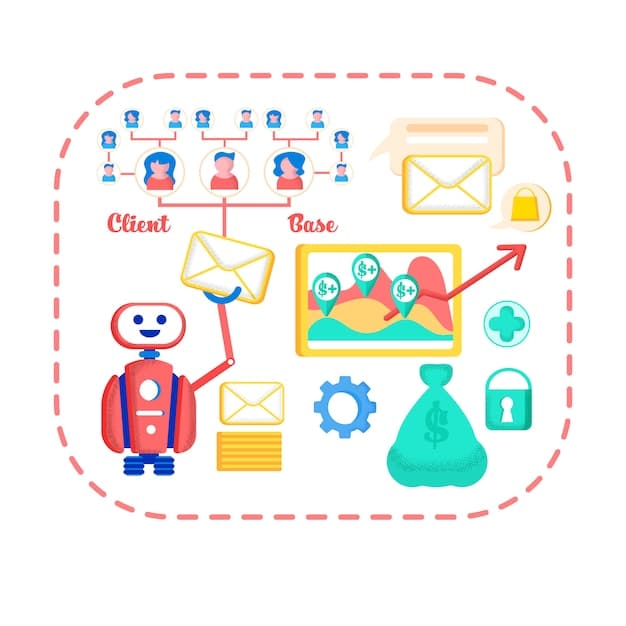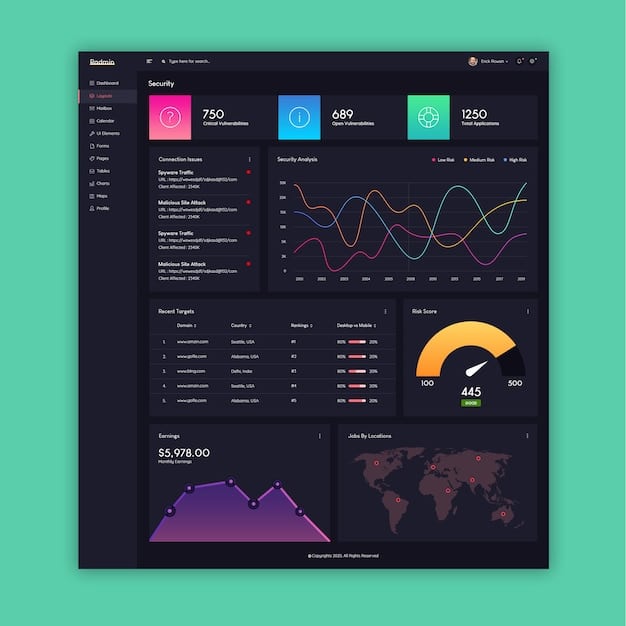Top 5 Automation Tools for US Entrepreneurs in 2025

In 2025, US entrepreneurs can reclaim 20 hours a week by leveraging online business automation tools. This article highlights the top 5 tools that streamline operations, boost productivity, and drive growth, enabling entrepreneurs to focus on strategic initiatives and achieve work-life balance.
Are you a US entrepreneur dreaming of more freedom and less busywork? The right top 5 online business automation tools for US entrepreneurs in 2025 (and how they can save you 20 hours per week) can transform your business, giving you back valuable time and boosting your bottom line. Let’s explore the solutions.
Unlock Your Potential: Automation in 2025
In today’s fast-paced digital landscape, automation is no longer a luxury but a necessity for US entrepreneurs. By strategically implementing automation tools, you can streamline repetitive tasks, improve efficiency, and focus on what truly matters: growing your business and achieving your goals.
Let’s dive into the world of business automation and discover how you can leverage these powerful tools to reclaim your time and unlock your entrepreneurial potential. Embrace the future of work and experience the transformative power of automation.

The Power of Automation: Saving 20 Hours a Week
Imagine having an extra 20 hours each week to dedicate to strategic planning, networking, or simply enjoying life. This is the promise of business automation. By automating routine tasks, you can free up your time and energy to focus on higher-value activities that drive business growth.
Identifying Automation Opportunities
The first step towards reclaiming your time is to identify areas in your business that can be automated. Consider tasks that are repetitive, time-consuming, and prone to errors. These are prime candidates for automation.
Benefits Beyond Time Savings
The benefits of automation extend far beyond simply saving time. Automation can also lead to increased accuracy, improved customer satisfaction, and reduced operational costs. By eliminating manual errors and providing instant responses, you can enhance the overall customer experience and build a stronger brand reputation. Automating tasks ensures consistency and frees up employees for more specialized assignments.
- Improved Efficiency: Streamline workflows and eliminate bottlenecks.
- Reduced Costs: Minimize manual labor and operational expenses.
- Enhanced Customer Experience: Provide instant support and personalized interactions.
By embracing automation, you can transform your business into a well-oiled machine, capable of operating at peak performance with minimal manual intervention. This enables scalable growth and reduces day-to-day anxiety.
Top 5 Automation Tools for US Entrepreneurs in 2025
Now, let’s explore the top 5 automation tools that US entrepreneurs should consider implementing in 2025. These tools are designed to address a wide range of business needs, from marketing and sales to customer service and operations.
1. HubSpot: The All-in-One Marketing Automation Platform
HubSpot is a comprehensive marketing automation platform that offers a suite of tools to manage your marketing, sales, and customer service efforts. With HubSpot, you can automate email marketing campaigns, social media posting, lead nurturing, and more.
2. Zapier: Connecting Your Apps for Seamless Workflow
Zapier is a powerful integration platform that allows you to connect your favorite apps and automate workflows between them. With Zapier, you can automate tasks such as adding new leads to your CRM, creating tasks in your project management tool, and sending email notifications.

3. Zendesk: Automating Customer Support for Enhanced Satisfaction
Zendesk is a leading customer service platform that enables you to automate your support processes and provide exceptional customer experiences. With Zendesk, you can automate ticket routing, response generation, and customer feedback collection. A great feature is having pre-written responses for common questions.
4. QuickBooks Online: Streamlining Financial Management with Automation
QuickBooks Online is a popular accounting software that offers a variety of automation features to streamline your financial management. With QuickBooks Online, you can automate tasks such as invoicing, expense tracking, and bank reconciliation. This helps small business owners stay compliant and keeps important tax documentation readily accessible.
5. Asana: Project Management Automation for Team Productivity
Asana is a project management tool that helps teams stay organized and productive by automating task assignments, deadline reminders, and project status updates. It eliminates bottlenecks, enhances team members’ accountability, and helps remote teams to stay connected with shared goals.
These top 5 automation tools represent a diverse range of capabilities, proving invaluable across various facets of a business. Integrating these tools strategically can result in significant gains in efficiency and productivity.
Implementing Automation: A Step-by-Step Guide
Implementing automation can seem daunting, but with a strategic approach, you can seamlessly integrate these tools into your existing workflows. Here’s a step-by-step guide to help you get started.
1. Assess Your Needs
Before you start implementing automation tools, take the time to assess your business needs and identify areas where automation can have the biggest impact. Consider your current processes, pain points, and goals.
2. Choose the Right Tools
Based on your needs assessment, select the automation tools that are the best fit for your business. Consider factors such as cost, features, ease of use, and integration capabilities. US Entrepreneurs should consider tools specifically tailored to the U.S. market due to regulatory and compliance concerns.
3. Start Small and Scale Gradually
Don’t try to automate everything at once. Start with a few key processes and gradually scale your automation efforts as you become more comfortable with the tools and techniques. This phased approach allows you to fine-tune your implementation and minimize disruptions.
- Train Staff: Ensure your team understands how to use the new tools.
- Monitor Results: Track the impact of your automation efforts.
- Optimize Workflows: Continuously refine to maximize efficiency.
The key to successful automation is to start small, scale gradually, and continuously optimize your workflows. With a thoughtful and strategic approach, you can transform your business and unlock its full potential.
Avoiding Common Automation Mistakes
While automation offers tremendous benefits, it’s important to avoid common pitfalls that can derail your efforts. Here are some tips to help you stay on track.
Don’t Automate Everything
Automation isn’t a one-size-fits-all solution. Some tasks are better left to humans, especially those that require creativity, empathy, or critical thinking. Focus on automating repetitive tasks and freeing up your team to focus on higher-level activities.
Don’t Neglect the Human Element
While automation can streamline many processes, it’s important to maintain a human touch in your customer interactions. Personalize your automated messages and provide opportunities for customers to connect with real people when they need assistance.
Don’t Ignore Data Security
When implementing automation tools, be sure to prioritize data security and protect sensitive information. Choose tools that offer robust security features and follow best practices for data privacy. US companies are becoming increasingly cognizant of data privacy concerns, hence your clients will expect you to be too.
By avoiding these common mistakes, you can ensure that your automation efforts are successful and deliver the desired results. Be mindful of the impact on people and data, and ensure that you’re automating for the right reasons.
The Future of Automation for US Entrepreneurs
As technology continues to evolve, automation will become even more sophisticated and accessible to US entrepreneurs. Here are some trends to watch in the coming years.
Artificial Intelligence (AI) Integration
AI-powered automation tools will become more prevalent, enabling you to automate complex tasks such as content creation, data analysis, and decision-making. AI will also enhance personalization and provide more intelligent insights.
Low-Code/No-Code Automation
Low-code/no-code platforms will empower non-technical users to build and customize automation workflows without writing code. This will democratize automation and make it accessible to a wider range of businesses. This is a significant leap from the traditional paradigm of coding that many small businesses struggle with.
Hyperautomation
Hyperautomation, the combination of multiple automation technologies, will become more common, enabling you to automate end-to-end business processes. This will lead to greater efficiency, agility, and innovation.
The future of automation is bright, and US entrepreneurs who embrace these technologies will be well-positioned to thrive in the years to come. By staying informed and adapting to the latest trends, you can harness the power of automation to achieve your business goals.
| Key Benefit | Brief Description |
|---|---|
| ⏱️ Time Savings | Automate tasks and reclaim up to 20 hours per week. |
| 📈 Increased Productivity | Streamline workflows and boost overall business output. |
| 💡 Improved Focus | Concentrate on strategic initiatives by offloading routine tasks. |
| 🛡️ Reduced Errors | Minimize manual data entry and other potential mistakes. |
Frequently Asked Questions (FAQs)
▼
You can automate a wide range of tasks, including email marketing, social media posting, customer service, invoicing, lead nurturing, and project management. Focus on repetitive, time-consuming tasks first.
▼
While the claim of 20 hours might be optimistic for all scenarios, many entrepreneurs report saving 10-15 hours per week through effective automation, allowing them to refocus their efforts on core business functions.
▼
Many automation tools offer affordable plans for small businesses, and some even have free versions. Prioritize the tools that deliver the most value for your specific needs and budget.
▼
Choose automation tools that prioritize data security and comply with industry standards. Implement strong passwords, enable two-factor authentication, and regularly back up your data to protect against data loss or security breaches.
▼
While technical skills are helpful, many automation tools are user-friendly and require minimal coding knowledge. Focus on developing skills in process analysis, workflow design, and data management to maximize the benefits of automation.
Conclusion
By embracing the top 5 online business automation tools for US entrepreneurs in 2025 (and how they can save you 20 hours per week), you can unlock new levels of efficiency, productivity, and growth. Take the time to assess your needs, choose the right tools, and implement automation strategically. The future of your business depends on it.





